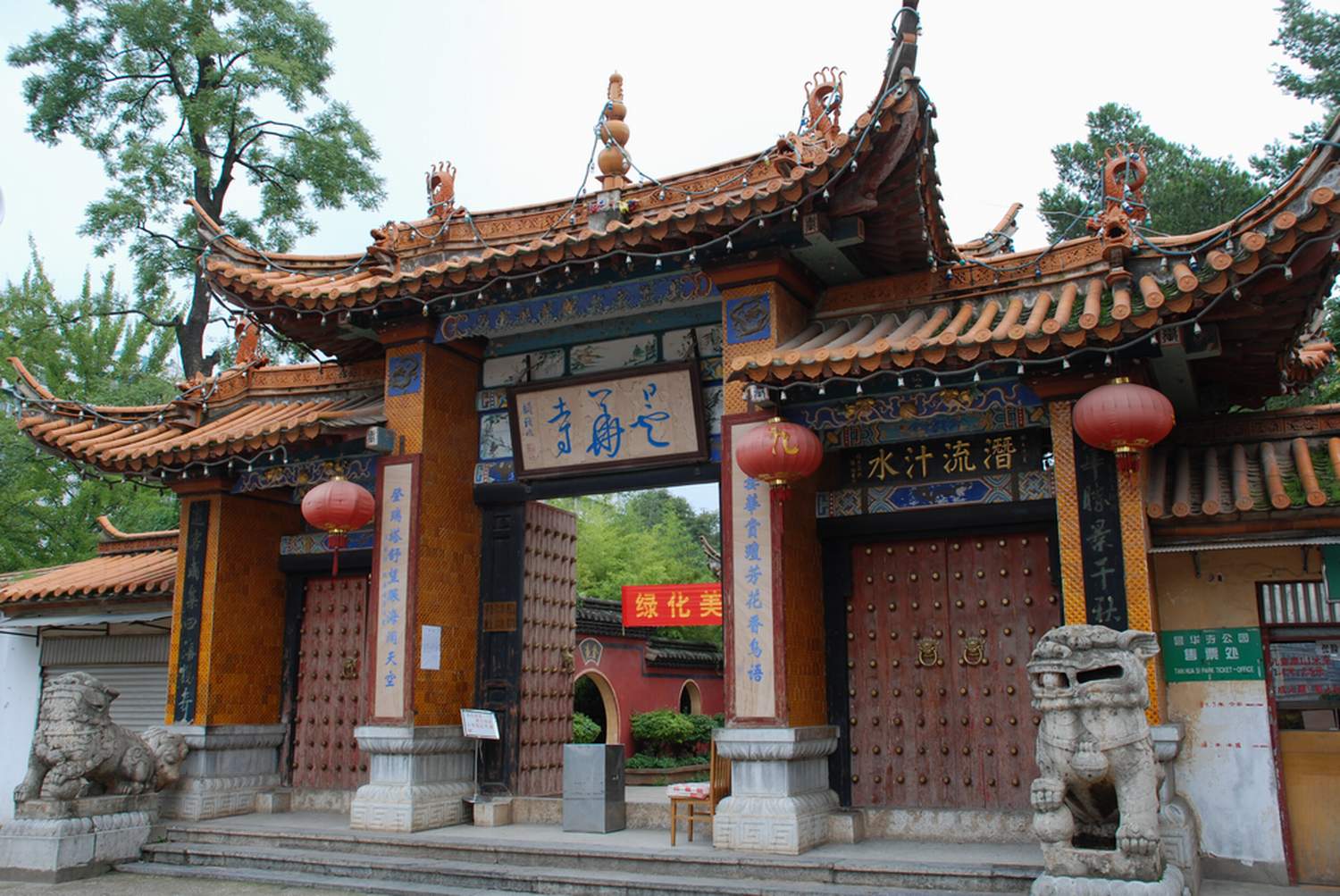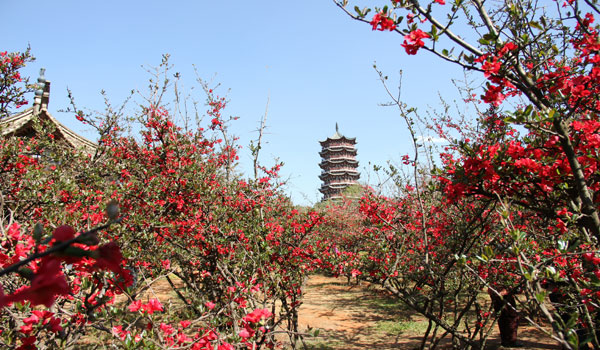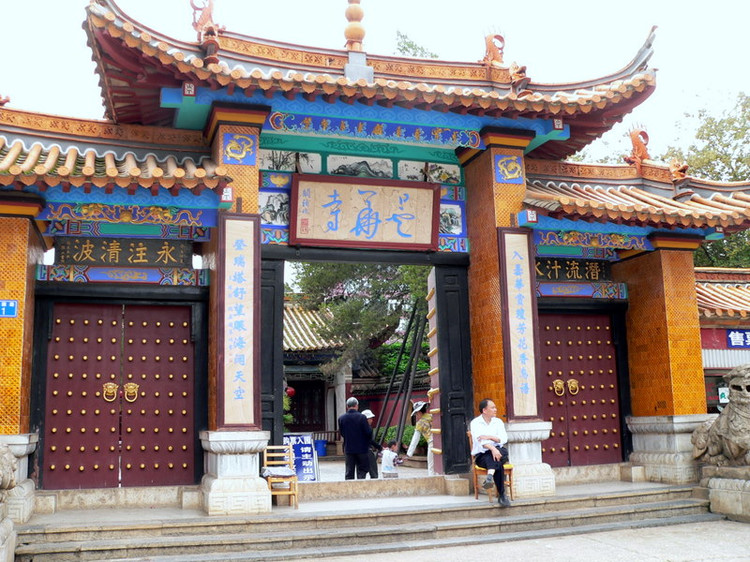
Tanhua Temple in Kunming,also called Taohu Nunnery, was built in 1634. It is located at the eastern outskirts of Kunming City. In the backyard there was an epiphyllum tree, which is called "tanhua" in Chinese and honored as the "Buddha's Flower", hence came the name "Tanhua Temple". The temple has been well-known for its flowers and plants ever since Yingding, the abbot, took charge of this temple. It has been a scenic spot for more than three hundred years, and an epitome of Kunming, "the Flower City of the Southern Frontier."

Hills, over the creek and about 1km north of where the #4 bus from Renmin Dong Lu terminates. There's little to see in the heavily restored Ming Buddhist temple, but the ornamental gardens are pleasant, with narrow paths winding around groves of exotic trees, bamboos, peonies and azaleas. "Tanhua" is a type of magnolia which grew here in profusion before the temple was built, though now just one slender, broad-leafed tree survives in a small courtyard next to the scripture hall.

Tanhua Temple is located at the foot of Mt. Tuiying of the Jinma Mountain range in the eastern outskirts of Kunming City, about 4 kUometres away from the city centre. According to historical records, before the temple was erected, there had been a thatched shack where Shi Shiqiao, a scholar of the Ming Dynasty, buried himself in books. During the reign of Chongzhen, Shi Tai, grandson of Shi Shiqiao, donated the estate for the shack whereon tanhua Temple was built. In the backyard there was an epiphyllum tree, which is called "tanhua" in Chinese and honoured as "Buddha's Flower", hence the name "Tanhua Temple".

Tanhua Temple was built by the end of the Ming Dynasty. It went through many renovations during the reigns of Kangxi (1662-1722) and Qianlong (1736-1795) in the Qing Dynasty. It has been well-known for its flowers and plants ever since Yingding, the abbot, took charge of this temple. It has been a scenic spot for more than three hundred years, and an epitome of Kunming, "the Flower City of the Southern Frontier." Yingding (1864- 1922), a native of Kunming came to the temple in his childhood, and studied Buddish sutras under Xuliang, the abbot. Xuliang loved the boy very much because he was clever and could memorize every word he had learned. He was later sent to study Confucian doctrines under Wang Zhongyu, a Confucian scholar. He attained great achievement in poetry. After the death of Xuliang, Yingding inherited the abbotship. His diligence changed the bleak temple into a garden "full of fragrance from flowers." His gardening skills were well known in the city.
The epiphyllum tree was planted in the side court of the depository of Buddhist Scriptures. There is a stone tablet on which four characters are carved: "The Epiphyllum Brings Luck." After the erection of the temple, the original epiphyllum withered and died. The epiphyllum nowstanding taller than the eaves of the temple sprang from the root of the original one at the beginning of the Qing Dynasty, and is about three hundred years old. The epiphyllum's leaves are broad and its twigs supple. It stands slim and graceful. When it bursts into flowers in mid-summer, the strong fragrance greets your nose, gladdens your heart and refreshes your mind. This epiphyllum is, in fact, a unique Yunnan magnolia, belonging to the lily magnolia family. It is an evergreen ornamental plant suitable for gardening. The big loquat tree in the backyard is said to have been planted in the early Ming Dynasty by Lan Mao (1397-1476), a famous doctor and the author of the book Meteria Medica of Yunnan.
[NextPage]
When you enter the gate, coming into view are flowers alongside the road and the wall which embraces a rockery studded with flowers. You seem to have come to a world of flowers.
In this south of the temple, there is the Southern Garden with flowers and rockeries. The peaks of the rockeries look like a forest, each having its own style. The exuberant azalea, cypress, magnolia and bamboo vie with the rockeries for beauty and gracefulness. The winding paths among the flowers and the zigzagging corridor surround the Lotus Pond, where you can watch fish. You are delighted to see fishjumping out of the water, and feel fascinated with the blooming of flowers.
In the east of the temple there is a the East Garden, covering about fifty mu shaded by tall cedars and cypresses. Within the garden there are seven small gardens, namely, Yi Jian Xuan, Peony Garden, Magnolia Garden, Azalea Garden, Camellia Garden, Chinese Flowering Crabapple and Cheery Garden, and Children's Playground. They are ingeniously connected by foot-paths and corridors. The beauty of these gardens lies not only in the matching of the flowers with plants, but also in the interior layout of each garden. You will be greeted by picturesque scenes wherever you rove in these gardens, which combine the classical architectural style with that of the minority nationalities in Yunnan. Tanhua Temple, though occupying a small area of less than a hundred mu, is so enchanting that visitors will linger on without any thought of leaving.
When he was in Yunnan, Zhu De (1886-1976), Commander-in-Chief of the People's Liberation Army, admired very much Monk Yingding's skills of cultivating magnolias and other flowers. He often went to see the flowers and enjoy a cup of tea together with Yingding, whose style of coriversation and calligraphy he more than admired. Soon they became close friends. In the early spring of 1922 when he visited the temple, Zhu De wrote a poem for Yingding, who carved it on a stone tablet to commemorate the event. On March 9th of the same year, Moon Yingding passed away but the stone tablet remains.
Admission Fee:¥0

You will only receive emails that you permitted upon submission and your email address will never be shared with any third parties without your express permission.
